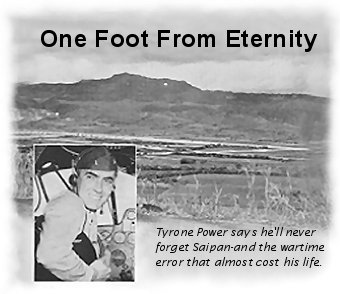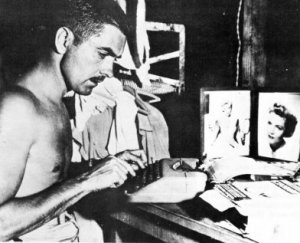

printed in Flying Magazine, May 1949
When I think of Saipan, I think of the Marines and
the C-46 I jockeyed around the Pacific during the war.
And every time I climb into a cockpit, I force myself to
re-live a hellish 30 seconds or so I spent on Saipan
while starting a routine flight mission. I re-live those
seconds because they taught me a flying fundamental I
don’t ever want to forget.
All pilots know that you can’t overlook the
checklist. It gets to be almost habit after a while. If
you’ve logged hundreds of hours in the same type of
plane, you give it that pre-flight check
automatically. You go back, you go forward, you go down,
you go across the instrument pattern.
 photo of Tyrone in Saipan, 1945
photo of Tyrone in Saipan, 1945(wife, Annabelle's photo on desk)
During the war I flew a Curtis Commando week
after week, month after month. I think I knew its
insides better than I knew what was in my pockets.
And, like a lot of other pilots, I got careless.
The hydraulic system on the C-46 is somewhat
complicated. Under the condition we flew the planes, the
seals for flaps and gear had a tendency to dry up
easily. We had to actuate them frequently to keep the
actuating cylinders flexible and to make certain we’d
lost no fluid from dried seals.
So, habitually, I’d actuate the flaps while waiting
on the line-just to make certain everything was all
right. I’d flip them up and down, up and down.
Then, taxiing, I’d flip them up and down again.
In our squadron it was SOP (standard operating procedure)to go through three full
cycles on the flaps. First, on the line or in the
revetment, again while taxiing for take-off, and once
again after final mag check.
That morning on Saipan I was hauled out of bed at 5
o’clock for a rush flight to Okinawa with a heavy load
of materiel and four or five men. I picked up my
co-pilot---a new one, checked the plane, and we were
ready to go.
I wanted to be extra certain those flaps were okay,
just in case I should need them on take-off. I made the
prescribed check in the revetment and another one while
taxiing for take-off. Then, while we sat there on the
end of the runway waiting for a bevy of planes to take
off, I checked it again. We went through the entire
check-off list.
My co-pilot got clearance, nodded to me, and off we
went. The C-46 scuttled down the runway while I kept
watching for the prescribed number of inches on the
manifold pressure. I knew immediately something was
wrong. The plane wanted to come off in about 1,000 feet!
And we were loaded to the gunwales.
Down the runway the plane barreled, trying to pull
off, with me pushing hard on the yoke to keep in on the
ground. Second by second we were eating up that runway,
roaring toward the end-and I had a quick vision of what
would happen: We were lurching along at 60 m.p.h. Then 65. And faster.
The last few feet of the runway would
be coming up soon, and I’d either have to chop those
throttles right away or there wouldn’t be time left to
do anything expect pray.
I couldn’t figure it out, though I was trying to
remember in those quick seconds everything that could
possibly be wrong. All I knew was that the darned plane
shouldn’t take off at that point, and yet it was tugging
and pulling to get off the ground. We were still
accelerating, and the remaining feet of the runway
looked like only inches.
Then off she roared. I couldn’t hold her down any
longer. As the plane lumbered off the runway, it seemed
to stagger. Desperately, I whipped a look around the
cockpit. Maybe the trim was off. I thought of a thousand
things, discarded them. I caught a glance at my
co-pilot, who about that time looked like a lad walking
the Last Mile.
And then we both looked down and at the same instant
saw what had happened.
I had left full flaps on the plane!
That spanking new co-pilot worked like a high -speed
machine. His arm shot down, and he dumped the flaps in a
fraction of a second.
There’s no need to tell pilots what happens when
you dump the flaps-especially with a heavily-loaded
plane the size of the Commando.
Ordinarily, the flaps would have been set at 15
degrees because any setting beyond that acts as a drag
and cuts down forward acceleration. Taking off with full
flaps, we became airborne faster (the tail just wouldn’t
stay down) but forward acceleration was slowed almost to
the stalling point.
So there we were. The co-pilot had dumped the flaps.
He knew what would happen then, and so did I felt like I
was piloting a big hunk of lead. We lost altitude-I
don’t know how much. I was too busy gunning the plane at
full throttle and rolling forward with all my might on
the trim tab to keep from stalling. The co-pilot
realized better that I that we were about one foot from
eternity.
My gear was up by this time, and we were still so low
that the prop tips were missing the ground by inches.
The red lights at the end of the runway were getting big
as cannon balls-and right behind them was a hill. Even
at that moment, while I was breaking out in a cold
nervous sweat, thought mirthlessly about the headlines
back home: “Tyrone Power’s Last Scene-A Smash Hit.”
But almost miraculously, we squeezed over that hill
with the old Commando’s engines screaming. The
rest of the ride to Okinawa was anti-climax. But today,
whether I’m flying a plane in California or in Rome, I
sit for a second or two before take-off and remember
that day on Saipan. It helps me remember that I’ve got a
lot to learn-and that in flying, you can’t afford to do
any forgetting.
non-profit site
© 2004-2011 tyrone-power.com
all rights reserved